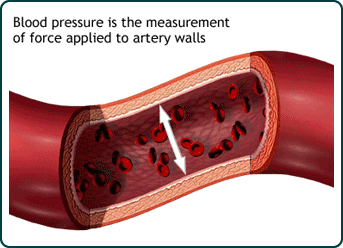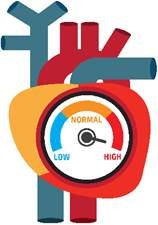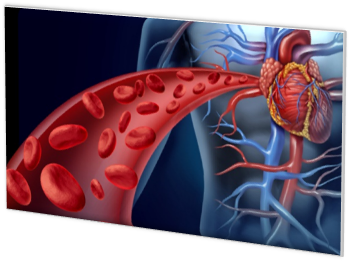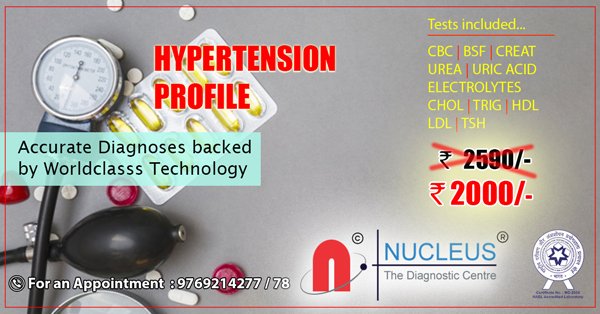Hypertension, also known as high blood pressure, is a persistent elevation in blood pressure that puts additional strain on the heart. Over time, it can cause serious damage to the heart as well as other organs, such as the kidneys, brain, and eyes.
Blood pressure (BP) is the force that blood exerts on the walls of the arteries. It depends on the strength and rate of the heart's contraction as it pumps blood and on the resistance to the flow of blood through the arteries. The amount of resistance depends on the elasticity and diameter of the blood vessels and the volume of blood flowing through them. The narrower the arteries and the more blood pumping through them, the higher the blood pressure will be. Maintaining a healthy lifestyle can help delay or prevent hypertension.

Blood pressure rises and falls during the day depending on a person's level of activity
and physical and emotional stress. Largely controlled by the autonomic nervous system
(the part of the nervous system that controls involuntary actions), BP is also affected
by several different hormones, including angiotensin II, aldosterone and
catecholamines.
Measuring BP takes into account two pressures, measured in millimetres of mercury (mm
Hg). The first, systolic pressure, is the force exerted on the blood vessel walls when
the heart is pumping blood. Diastolic pressure reflects the force present when the heart
relaxes between beats. They are written as systolic over diastolic pressure. For
instance, a blood pressure of 120/80 mm Hg or 120 over 80 corresponds to a systolic
pressure of 120 and a diastolic pressure of 80.
A single measurement of blood pressure is not diagnostic. Typically, multiple readings
are taken on different days and, if measurements are consistently high, a diagnosis of
high blood pressure is made.

Signs and Symptoms
In most people, high blood pressure rarely causes any signs or symptoms. It's possible to
have it for many years without realizing it. Often, it only becomes apparent during a
routine health check-up. Rarely, even when levels are life-threatening, high blood
pressure may cause only a few symptoms, such as headaches, dizziness, or frequent
nosebleeds.
For this reason, hypertension is known as the "silent killer," quietly
increasing the risk of developing stroke, heart disease, heart attack, kidney damage,
and blindness. The greater the blood pressure for extended periods, the greater the
potential for damage. That is why it is important for people to have their blood
pressure checked on a regular basis.

Causes
In most cases, the cause of hypertension is unknown, or idiopathic. Women are about as
likely as men to develop high blood pressure, though this varies somewhat by age. For
people younger than age 45, more men than women are affected, while for those age 65 and
older, more women than men are affected. Although it may not be possible to identify the
cause of hypertension, several factors are known to increase the risk and worsen high
blood pressure. These include:
• Obesity
• Sedentary lifestyle - not getting enough exercise
• Smoking cigarettes or using other tobacco products
• Drinking excessive amounts of alcohol
• Excessive dietary sodium
• Use of oral contraceptives or hormone therapy
• Use of drugs such as steroids, cocaine, and amphetamines
• Aging
• Family history
Hypertension that is due to one or more identifiable underlying conditions or use of
drugs is called secondary hypertension and accounts for 5% of those who have high blood
pressure. It is important to identify the underlying conditions since their treatment
may result in a person's blood pressure returning to normal or near normal levels.
Examples of conditions that result in secondary hypertension include:
Kidney disease or damage – decreases the removal of salts and fluids from the body,
increasing blood volume and pressure. Since hypertension can also cause kidney damage,
this can be a progressive problem if left untreated.
Heart disease – this may affect the force and rate of the heart's contraction. This
can also be progressive.
Diabetes – this condition can damage the kidneys and affect the integrity of the blood
vessels over time.
Arteriosclerosis – a hardening of the arteries that limits their ability to dilate and
constrict
Cushing syndrome – a disorder that involves increased production of the hormone
cortisol by the adrenal gland
Hyperaldosteronism (Conn syndrome) – a condition characterized by an overproduction of
aldosterone, a hormone that helps regulate the retention and excretion of sodium by the
kidneys; it may be due to an adrenal gland tumor (usually benign).
Pheochromocytoma – a tumor of the adrenal gland (rare and usually benign) that
produces excessive amounts of epinephrine (adrenaline); epinephrine is one of a group of
hormones called catecholamines that are produced by the brain and adrenal glands in
response to stress. People with a pheochromocytoma often have severe episodes of
hypertension.
Thyroid disease – both excessive and deficient amounts of thyroid hormone production
can cause increases in blood pressure.
Pregnancy – hypertension may develop at any time during a woman's pregnancy but is
most common during the last trimester, when it can cause pre-eclampsia (toxaemia), a
condition characterized by increased blood pressure and retention of fluids.
Laboratory Tests
Laboratory testing is not diagnostic for hypertension, but tests are frequently ordered
to detect conditions that may cause and/or make high blood pressure worse and to
evaluate and monitor organ function over time.
Examples of general lab tests that may be ordered include:
o Urinalysis, urine protein – to help assess kidney function
o Urinary albumin (microalbumin), BUN (blood urea nitrogen), creatinine, estimated
glomerular filtration rate (eGFR) – to detect and monitor kidney dysfunction or to
monitor the effect of medications on the kidneys
o Potassium – as part of the electrolyte panel, which also includes sodium, chloride,
and carbon dioxide (CO2); to evaluate and monitor the balance of the body's
electrolytes. For example, low potassium can be seen in Cushing syndrome and Conn
syndrome, two causes of secondary hypertension. Some high blood pressure medications can
upset electrolyte balance by causing excessive loss of potassium or potassium
retention.
o Fasting glucose, A1c – to help diagnose diabetes and to monitor glucose control over
time in people with diabetes
o Calcium – to determine how much total calcium or ionized calcium is circulating in the
blood; increased activity of the parathyroid glands, which produces an increase in serum
calcium, is associated with hypertension.
o TSH (thyroid stimulating hormone) and T4 – to detect and monitor thyroid
dysfunction
o Lipid profile – to evaluate levels of total cholesterol, HDL cholesterol, LDL
cholesterol and triglycerides and assess the risk of developing atherosclerosis
o The basic metabolic panel (BMP) includes several of the tests listed above, so it may
be ordered instead of the individual tests.
Based on an individual's medical history, physical findings, and routine laboratory test
results, some select, non-routine tests may be ordered to help detect, diagnose, and
monitor conditions causing secondary hypertension. Examples include:
o Aldosterone and renin – to help detect the overproduction of aldosterone by the
adrenal glands (which may be due to a tumor) or renin by the kidneys (which may be due
to kidney damage or narrowing of the arteries bringing blood to the kidneys)
o Cortisol and dexamethasone suppression test – to detect an overproduction of cortisol
that may be due to Cushing syndrome
o Catecholamines and metanephrines – primarily to help detect the presence of a
pheochromocytoma that can cause episodes of severe hypertension.
Prevention and Treatment
Lifestyle changes can help lower the risk of developing hypertension. For many people
with mild high blood pressure, reaching and maintaining a healthy weight, exercising
regularly, limiting alcohol and salt, and stopping smoking can decrease blood pressure
levels to normal and may be the only "treatment" required. Risks associated
with sex (gender), race, and increasing age, however, do not disappear with lifestyle
changes and, in many cases, a treatment plan that includes medications is necessary to
control high blood pressure..







